Cooked in savory dashi broth seasoned with soy sauce and sake, this classic Japanese Simmered Kabocha Squash makes a satisfying and healthy side dish that is chock-full of nutrients. {vegan/vegetarian adaptable}
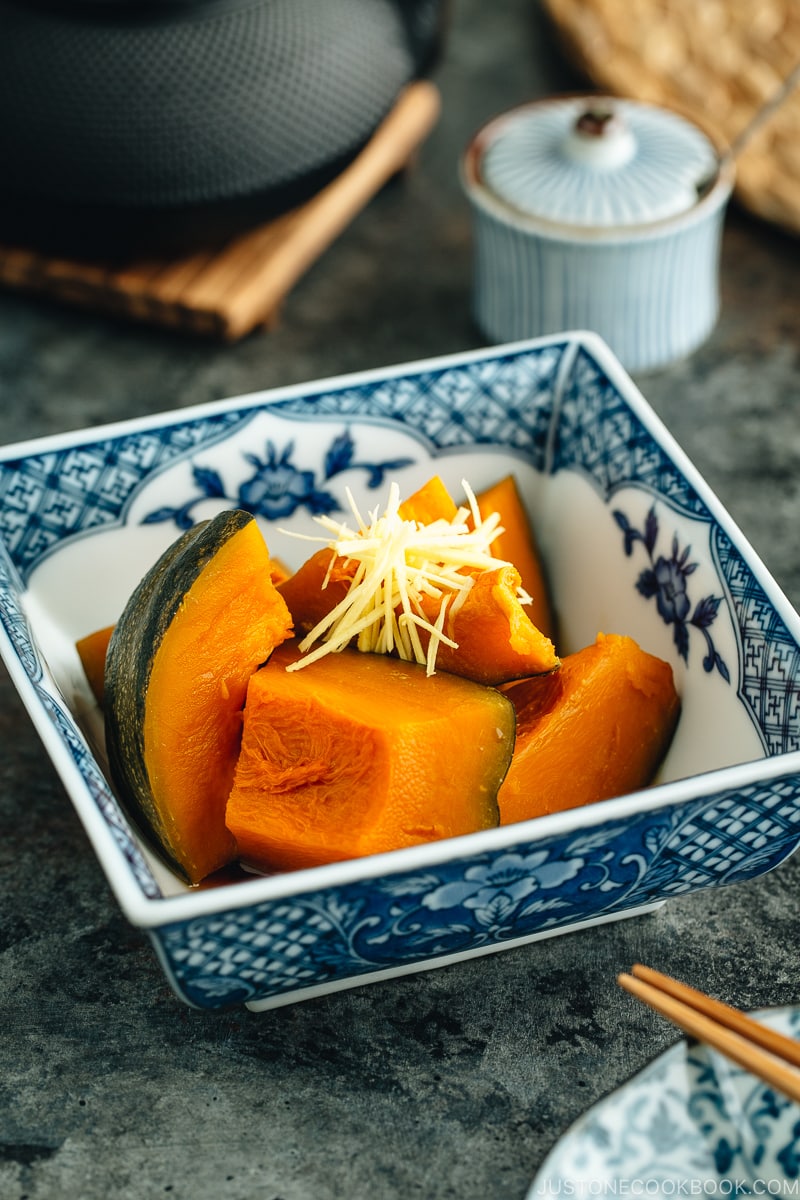
Japanese Simmered Kabocha Squash, or what we call Kabocha no Nimono (かぼちゃの煮物), is one of the most classic and popular simmered dishes in Japan. If you are traveling in Japan, you will see this kabocha dish everywhere. You‘ll see it in the bento box you pick up at the train station, as part of the side dishes of your teishoku (lunch meal set), or at the breakfast buffet in your ryokan (Japanese inn).
If you miss this hearty, comforting home-cooked dish, grab a kabocha squash at your local Japanese or Asian grocery store. It‘s easy to make this at home!
Table of Contents
Japanese Simmered Dish – “Nimono”
A typical Japanese home-cooked meal includes at least one simmered dish called Nimono (煮物). It can be fish or meat or different types of root vegetables all cooked and simmered in one pot. Wholesome, nutritious, and easy to prepare, these simmered dishes are considered true home cooking in a Japanese kitchen. And they make up a fundamental part of washoku (和食).
It might be surprising to you, but most of the simmered dishes are seasoned similarly – with some kind of Japanese stock, dashi (see 6 varieties here), sake, mirin, soy sauce (and sugar). What makes it different?
Based on the ingredients, we modify the ratio of the seasonings. For example, kabocha squash itself is already very sweet and flavorful, so we go easy on the sweetness (mirin or sugar) and cut down on soy sauce since we don’t want the saltiness to overpower the dish. When it comes to dashi, you can use kombu dashi, the combination of kombu and katsuo dashi, or katsuo dashi, like I used today.
3 Important Cooking Tips
1. Cut kabocha into equal size
Do not underestimate this simple tip. To make sure all the squash pieces are evenly cooked, you want to cut the kabocha squash in similar sizes. Smaller cubes will help speed up the cooking time as well.
2. Place kabocha in a single layer
Kabocha is very fragile once it’s cooked and it can break into pieces or mush easily. Therefore, you need to secure each kabocha piece, making sure they are laid in a single layer without overlapping in the pot. Then swirl the pot to mix the seasonings instead of using cooking utensils.
3. Simmer kabocha squash with just enough liquid and an otoshibuta
The amount of cooking liquid should be just enough to come to the top level of kabocha pieces in the pot. Overfilling with cooking liquid will only result in soupy kabocha, which we want to avoid.
Make sure to use an Otoshibuta (drop lid) so that the cooking liquid is forced to circulate, allowing the kabocha to cook evenly and quickly as they absorb the flavor.
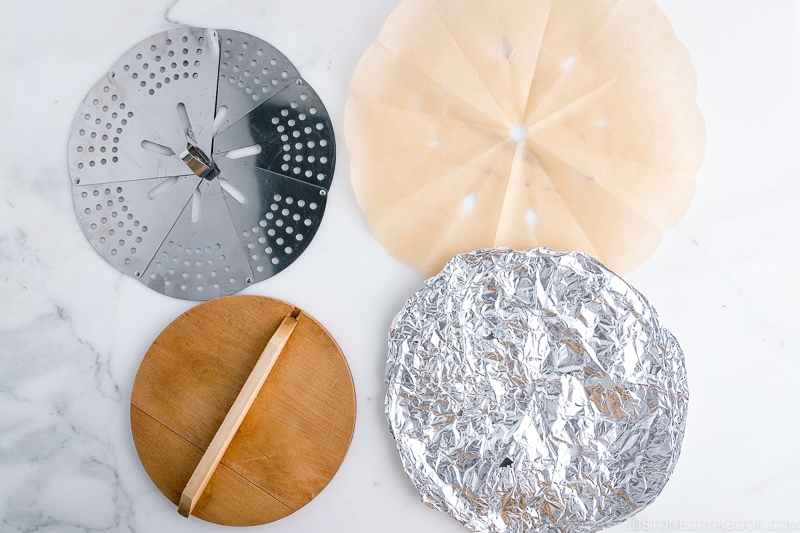
Truly simple and rustic, I hope you enjoy making this Simmered Kabocha Squash recipe, especially in fall and winter. To experience more Japanese home cooking, check out other Nimono recipes on my blog and leave a comment below and let me know the kind of simmered dishes you have in mind.
Other Kabocha Squash Recipes
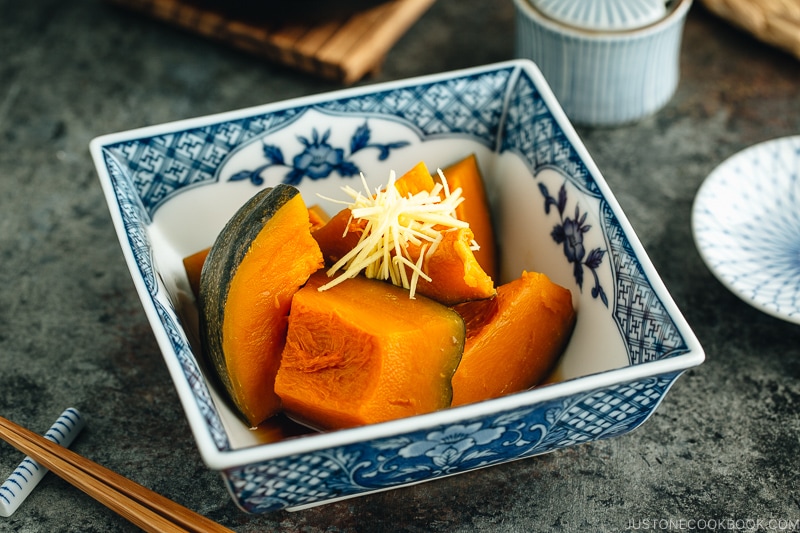
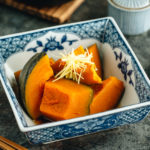
Japanese Simmered Kabocha
Ingredients
- 1 lb kabocha squash (½ small kabocha)
For the Dashi
- 1¾ cups water
- ½ cup katsuobushi (dried bonito flakes) (alternatively, you can use Kombu Dashi or Awase Dashi; for vegan/vegetarian, make Vegan Dashi with shiitake and kombu)
For the Seasonings
- 2 Tbsp sake
- 1 Tbsp sugar
- 2 tsp soy sauce
- ⅛ tsp Diamond Crystal kosher salt
For the Garnish (optional)
- ginger (julienned; from 1-inch, 2.5-cm knob)
Instructions
- Gather all the ingredients.
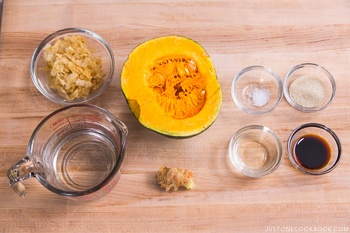
- In a small saucepan, boil 1¾ cups water for the dashi. Once boiling, add ½ cup katsuobushi (dried bonito flakes).
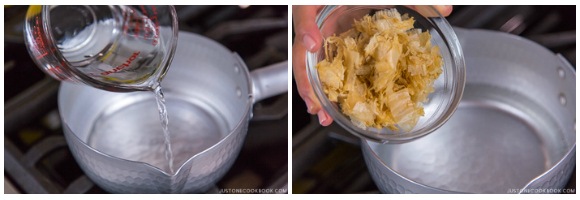
- Mix together and turn off the heat. Set aside for 15 minutes. Then, strain the katsuobushi with a fine-mesh sieve. Now you have Katsuo Dashi. Set it aside for now. Reserve the spent katsuobushi to make furikake (rice seasonings).
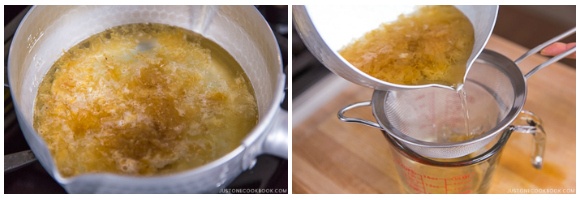
- Remove the seeds and membrane from 1 lb kabocha squash and microwave it for 2 minutes to soften the outer skin. You can skip microwaving if you have a sharp knife and the strength to cut through the hard kabocha.

- Carefully cut the kabocha into wedges, then equal 2-inch (5 cm) pieces. Remember, we leave the skin on because kabocha skin is edible and nutritious.

- In a large pot, place the kabocha pieces in a single layer, skin side down.
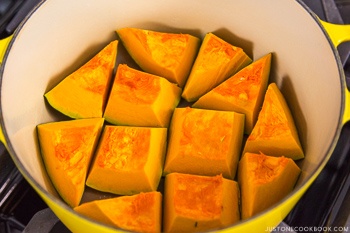
- Add the dashi, 2 Tbsp sake, and 1 Tbsp sugar. Tip: Swirl the pot to mix the seasonings so you don‘t break the kabocha pieces.

- Cook on medium high heat and bring it to a boil.
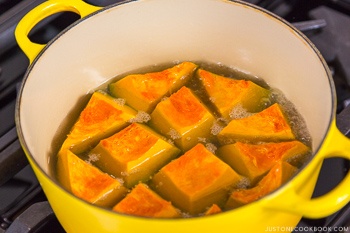
- Add 2 tsp soy sauce and ⅛ tsp Diamond Crystal kosher salt, and swirl the pot again to mix the seasonings. The cooking liquid should come three-quarters up the sides of the kabocha pieces; if it does not, you can add a little bit of water. Bring it to a boil again.

- Once boiling, turn the heat to medium low to maintain a simmer. Cover with an otoshibuta (drop lid) and cook for 20–30 minutes (depending on the size of your kabocha pieces and how long it takes the skin to cook). You can tell it‘s done when the orange flesh of the kabocha has tiny, thin cracks near the skin or a bamboo skewer pierces the kabocha easily. If you feel that the liquid is evaporating too fast, you can cover the pot with a pot lid (with the otoshibuta still placed on top of the kabocha).
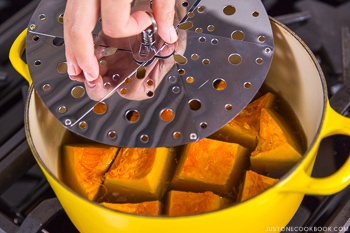
- Remove from the heat and let the kabocha sit covered with a pot lid until cool, about 30 minutes. This helps the kabocha absorb more flavor as it cools. You can serve it at room temperature or reheat before serving.
To Garnish (optional)
- Cut the ginger into thin slabs and then thin julienne strips.
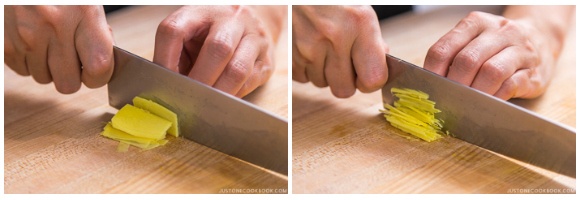
- Soak in cold water for 1 minute to remove some of the spiciness and drain well. Sprinkle the ginger on top of the simmered kabocha and serve.
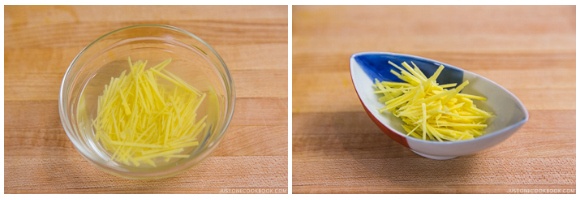
To Store
- You can keep the leftovers in an airtight container and store in the refrigerator for 2–3 days or in the freezer for a month.
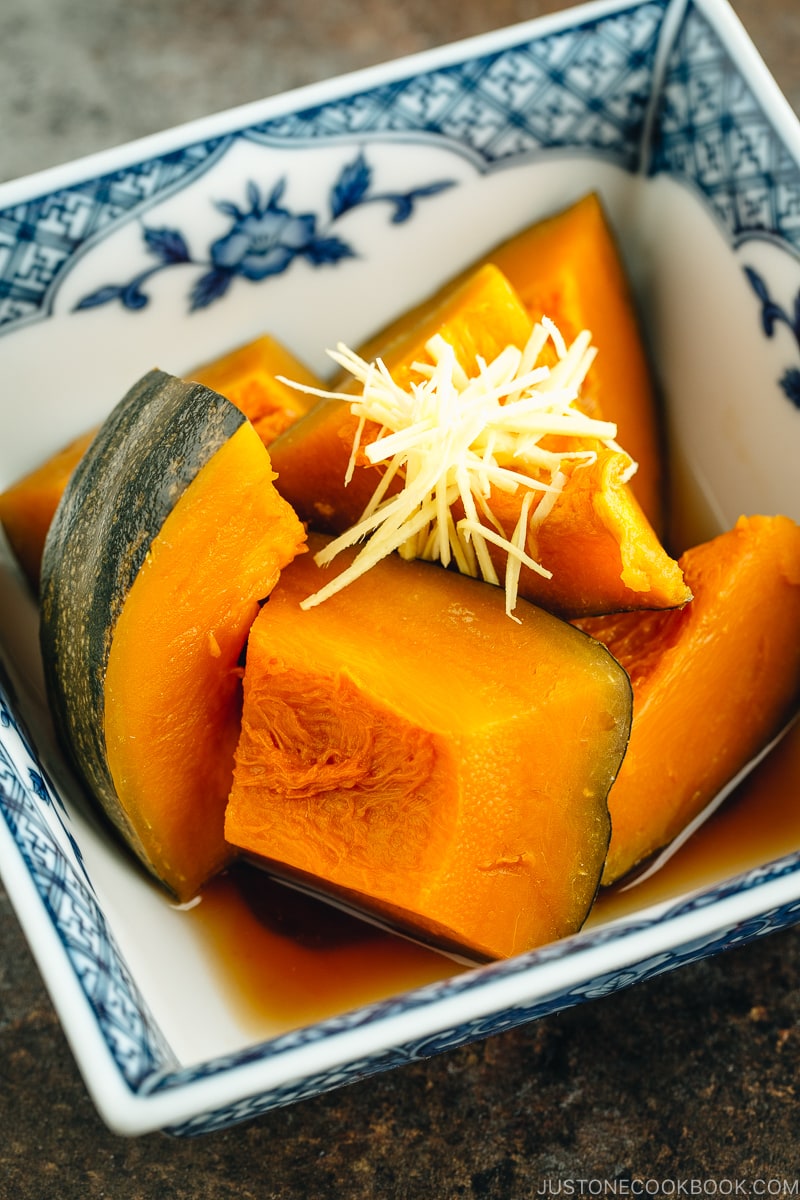
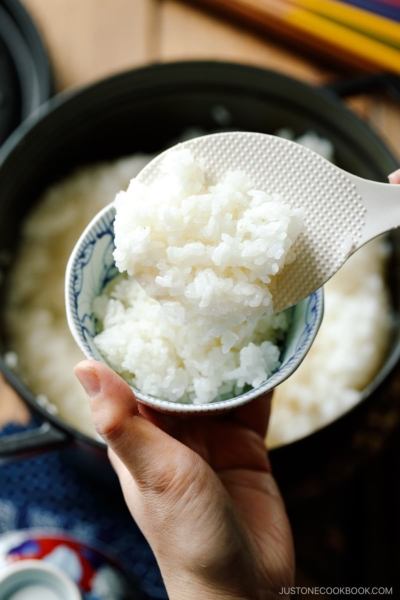
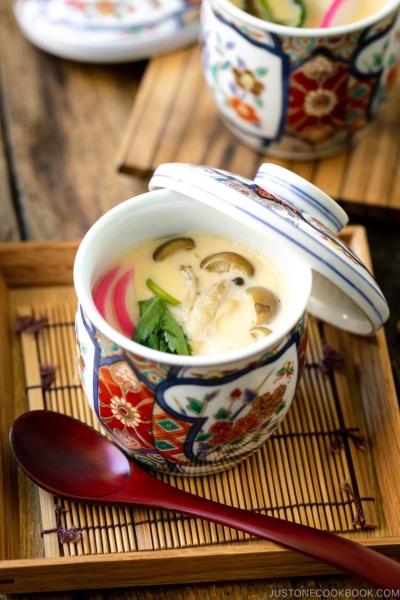
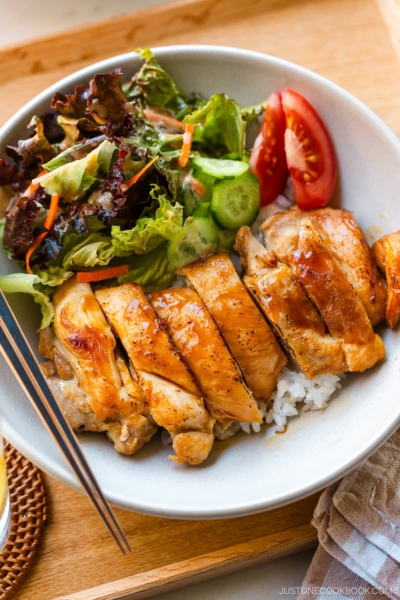
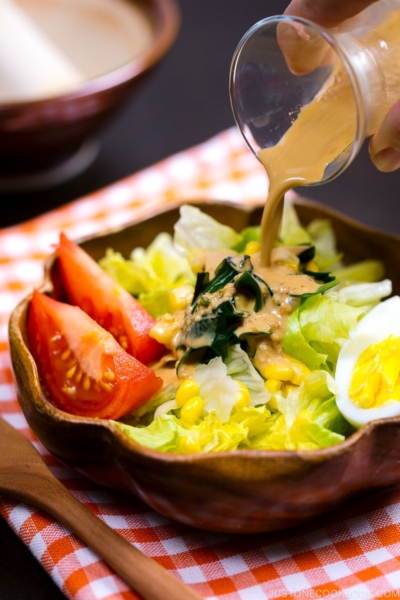
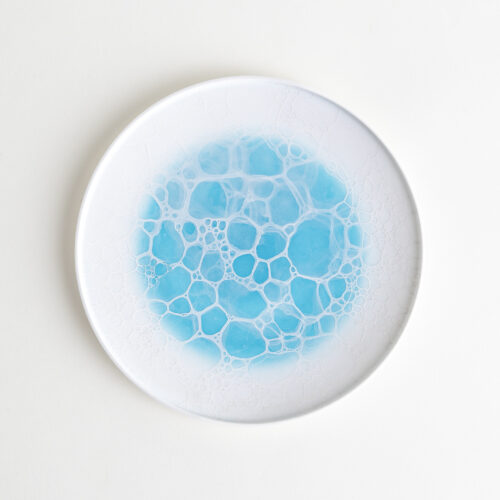
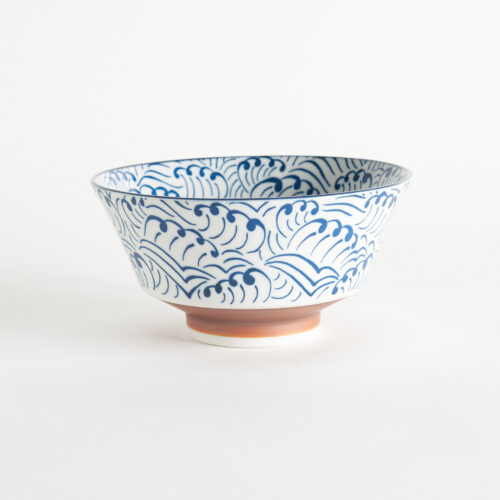
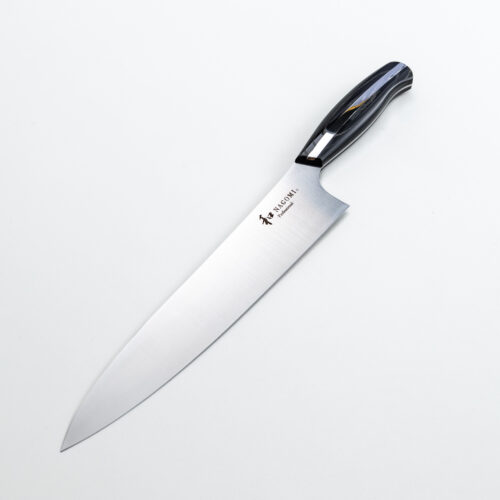
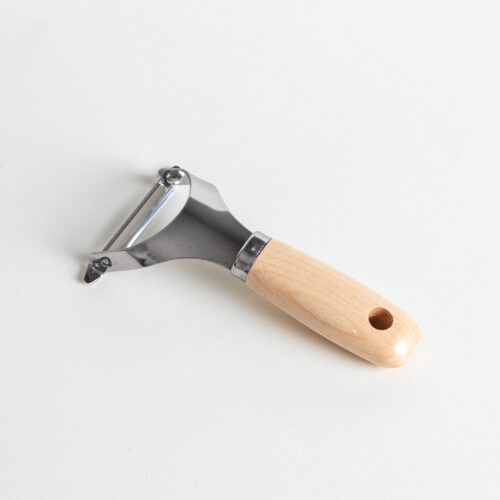

The flavor was nice, but I was not prepared for the texture of this dish. It’s quite chalky compared to other pumpkins and squashes. We ended up letting the leftovers go to waste.
Hello, Biev! Thank you for trying Nami’s recipe and providing feedback.
We’re sorry to hear the Kabocha texture was not what you expected. Here is Nami’s post on Kabocha, as well as her other Kabocha recipes. We hope this information is helpful!🙂https://www.justonecookbook.com/kabocha/